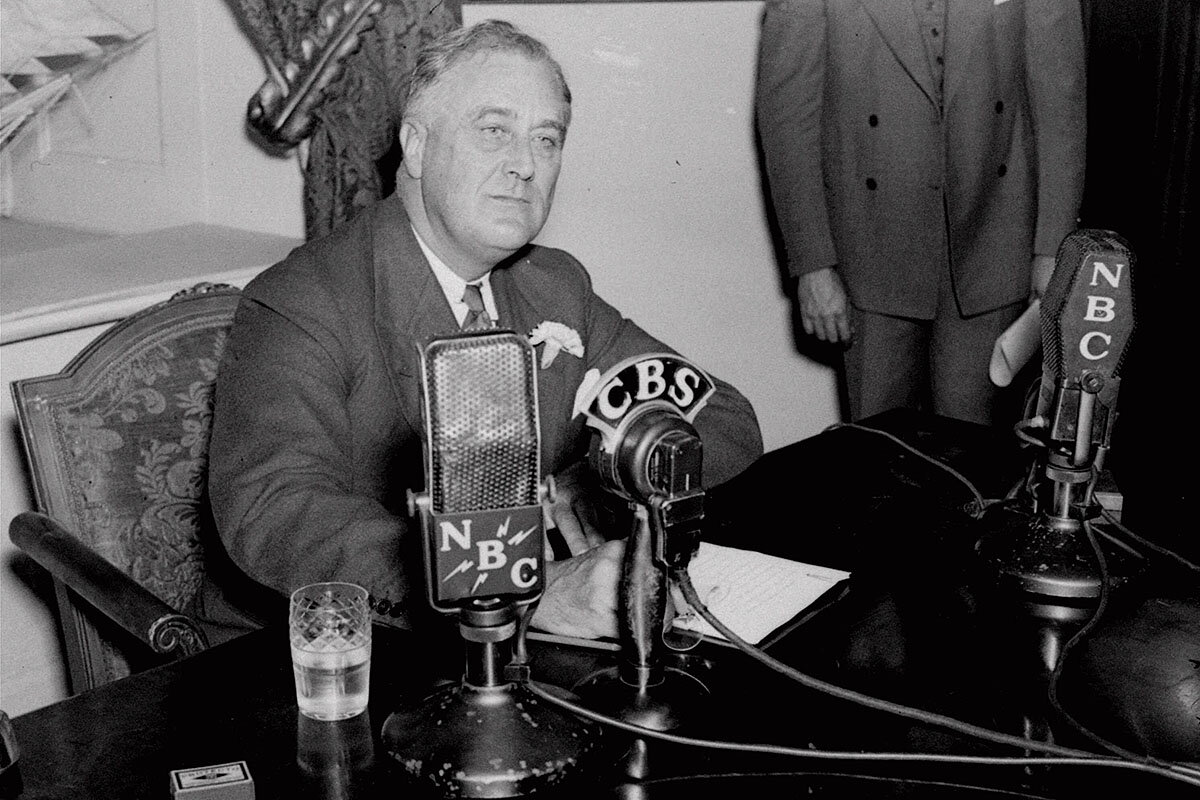At key moments, the power of a president’s words
| WASHINGTON
At a time of crisis, one of the most effective things a president can do is speak to the nation directly, in an effort to keep the public informed and allay fears.
But not all presidential addresses hit their mark.
When President Donald Trump spoke from the Oval Office Wednesday night about the coronavirus pandemic, he appeared ill at ease, misstating numerous aspects of his government’s own plan, and even sprinkling in campaign rhetoric.
Why We Wrote This
Allaying fear and rallying the nation is a critical task for any leader at a time of crisis. But downplaying the challenge or misstating fundamental facts can severely undercut the public’s confidence.
Thursday morning, investors spoke. Within minutes of the markets’ opening, the S&P 500 plummeted 7%, triggering the “circuit breaker” and halting trading.
The president’s instinct to try to project calm was no doubt correct – and part of a long-standing American tradition of presidential efforts to rally the nation at times of crisis, from Franklin Roosevelt’s fireside chats to Bill Clinton’s speech after the Oklahoma City bombing to George W. Bush’s bullhorn moment in New York City after 9/11.
But as a norm-busting leader who is often short on the nuts and bolts of governance, Mr. Trump has so far struggled to meet this moment.
The speech was “not reassuring,” says Paul Light, a professor of public service at New York University. “It will not go down in history as one of the great moments of calm, where the president has used his or her great skills at reassurance to get people to relax, and say, ‘This is going to be OK.’”
Public health experts say the speech failed to level with Americans about just how much their day-to-day lives may be about to change – or how important their own actions will be in helping to address the challenge, with specific social-distancing measures, for example.
Most glaring were the three factual errors: Mr. Trump asserted, incorrectly, that the suspension of travel from Europe would include “trade and cargo.” He failed to mention that the ban on flights from Europe would not apply to U.S. citizens, legal residents, or immediate family of citizens. And he misstated the “waiver” of insurance copayments around coronavirus; it applies to testing, but not treatment.
After the speech, the White House quickly corrected the mistakes, but not before U.S. stock futures and overseas markets spiraled.
Mr. Trump’s performance stood in stark contrast to that of German Chancellor Angela Merkel, a physicist by training, who spoke to her own nation on Wednesday, and delivered bad news in her signature, no-nonsense style: Two-thirds of Germans may become infected, she said.
Not all presidents get it right when trying to reassure the nation. And while sugarcoating bad news is never a good idea, an overly negative tone can be problematic as well. In 1979, President Jimmy Carter delivered a downbeat speech as the United States grappled with gas lines, unemployment, and inflation. It is now famously remembered as the “malaise speech,” even though President Carter never used that word. The following year, he lost his reelection bid.
Since the start of the coronavirus situation – and as recently as Monday – Mr. Trump has blamed “fake news” and the “Democrat Party” for trying to sow panic and hurt him politically.
When asked Thursday morning on NBC’s “Today Show” about Mr. Trump’s word choices, Vice President Mike Pence acknowledged that “there’s been some irresponsible rhetoric,” without saying whom he was referring to.
“The American people should know President Trump has no higher priority than the health and safety and well-being of the people of this country,” Vice President Pence added.
Perhaps Mr. Trump’s biggest challenge right now is a trust deficit, given his own well-established history of misstatements, misleading assertions, vague language, and even outright lies. All presidents dissemble or lie at times, but Mr. Trump’s verbal habits are unprecedented for an American president – though perceived in sharply different ways, depending on voters’ party affiliation.
On his handling of coronavirus itself, voters so far are just as divided: Eighty-seven percent of Republicans approve, 83% of Democrats disapprove, and independents are split 50-50, according to a Quinnipiac poll. Overall, 43% of registered voters approve, and 49% disapprove.
Add to the mix the November election, and Mr. Trump’s drive for a second term. In his Oval Office address, even as he warned the American public about the potential grave dangers ahead, he threw in campaign-style flourishes.
“Because of the economic policies that we have put into place over the last three years, we have the greatest economy anywhere in the world by far,” the president said.
Indeed, the American economy remains a bulwark against the challenge that coronavirus presents, experts say. But there’s no doubt that the virus is presenting a serious economic threat, as reflected in the tanking markets.
Mr. Trump’s political team has not skipped a beat since the Wednesday address. On Thursday morning, the Trump campaign – working in concert with the Republican National Committee – sent out an email slamming “liberal reporters” that begins, “The mainstream media has become completely UNHINGED.”
Former Vice President Joe Biden, now in a strong position to win the Democratic presidential nomination, delivered his own address to the nation on the coronavirus situation on Thursday. It all seemed aimed at creating the appearance of a “shadow government,” waiting in the wings to take power, as in a parliamentary system. Mr. Biden announced he was releasing a comprehensive plan to combat the virus, calling it “a road map, not for what I will do as president 10 months from now – but for the leadership that I believe is immediately required at this very moment.”
He added, “President Trump is welcome to adopt all of it today.”







